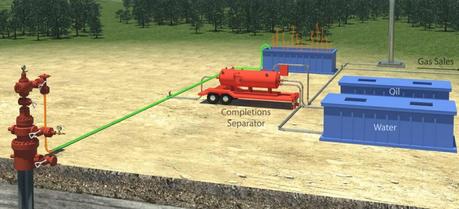 (Credit: University of Texas at Austin)
(Credit: University of Texas at Austin)A new study from The University of Texas at Austin reports on extensive measurements of methane emissions from fracking—including the first measurements for methane emissions taken directly at the well pad—during completion operations for hydraulically fractured wells.
The study (see footnote) reports direct measurements of methane emissions at 190 onshore natural gas sites in the United States. During the yearlong study, the UT-led study team selected times and general locations for sampling activities, and companies provided access to completions that occurred during those periods. Production sites near the completions were selected by the study team for sampling based on lists of available sites in the region provided by the participating companies. The sampling was designed to be representative of company operations in the Gulf Coast, Mid-Continent, Rocky Mountain and Appalachian regions. Measurements of active equipment at 150 production sites with 489 wells, 27 well completion flowbacks, nine well unloadings and four well workovers were included in the study. The types of sources measured account for two-thirds of methane emissions that occur during natural gas production, as estimated in the most recent national greenhouse gas inventory.
Measured emissions from completion flowbacks were much lower than previously estimated. During hydraulic fracturing, liquids that typically consist of water, sand and additives are injected at high pressure into low-permeability formations. After a well is fractured, it is cleared of sand and liquids that were injected into the well in a process called completion flowback. Two-thirds of the well completion flowbacks measured in the study either captured or combusted emissions, resulting in emissions measurements that were 99 percent lower than would have occurred in the absence of capture and combustion. The remaining one-third of completion flowbacks vented methane, but these were low-emitting wells, so in total, the emissions from completion flowbacks were 97 percent lower than current EPA estimates.
The study’s measurements of methane emissions from equipment leaks on well sites were comparable to current EPA estimates for this type of equipment; when scaled to national emission estimates, however, the study’s estimated emissions are higher than EPA estimates that include assumed voluntary reductions. The study also showed higher emissions for certain types of pneumatic devices used for controlling mechanical processes. Pneumatic devices, which are designed to release small amounts of methane in normal operation, were found to have emissions that were on average 70 percent higher than estimates in the EPA national inventory.
The study team made the first reported measurements of unloading emissions, collecting data for nine wells. In a liquids unloading, wells are cleared of water and other liquids that are inhibiting production. Wells may be unloaded daily, weekly, monthly, yearly, or not at all, depending on the geology of the formation. Because unloadings are intermittent, complex, and vary in frequency and characteristics between production regions, the researchers believe that a larger sample size is required to accurately characterize an average emissions rate.
Overall, if emission factors from this study for completion flowbacks, equipment leaks, and pneumatic pumps and controllers are assumed to be representative of national populations and are used to estimate national emissions, total annual emissions from these source categories are calculated to be 957 Gg of methane (with sampling and measurement uncertainties estimated at ±200 Gg). The estimate for comparable source categories in the EPA national inventory is ∼1,200 Gg.
This study, focused on natural gas production, is part of a larger research effort spearheaded by the Environmental Defense Fund to measure methane emissions throughout the natural gas supply chain. Results for the studies addressing other parts of the supply chain will be reported during the next 12-18 months.
Allen DT, Torres VM, Thomas J, Sullivan DW, Harrison M, Hendler A, Herndon SC, Kolb CE, Fraser MP, Hill AD, Lamb BK, Miskimins J, Sawyer RF, & Seinfeld JH (2013). Measurements of methane emissions at natural gas production sites in the United States. Proceedings of the National Academy of Sciences of the United States of America PMID: 24043804
